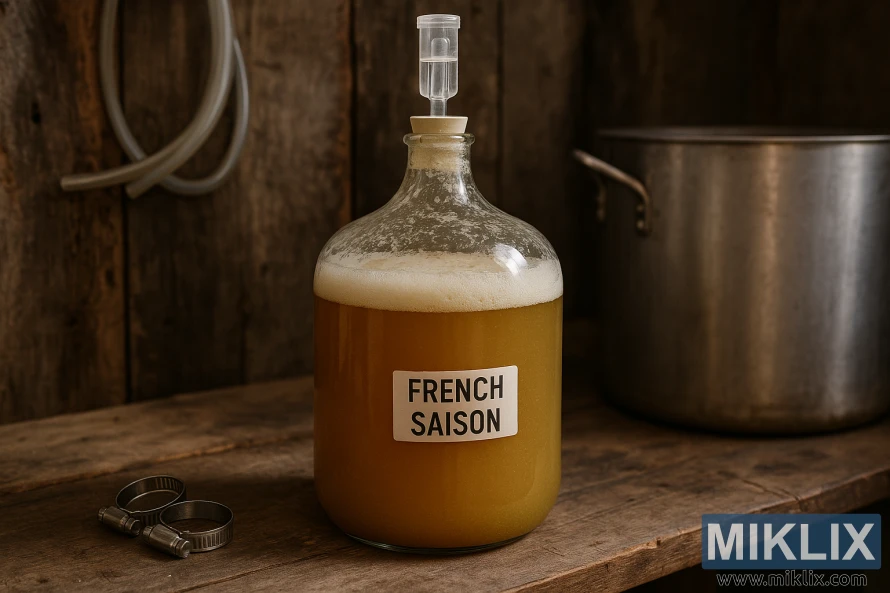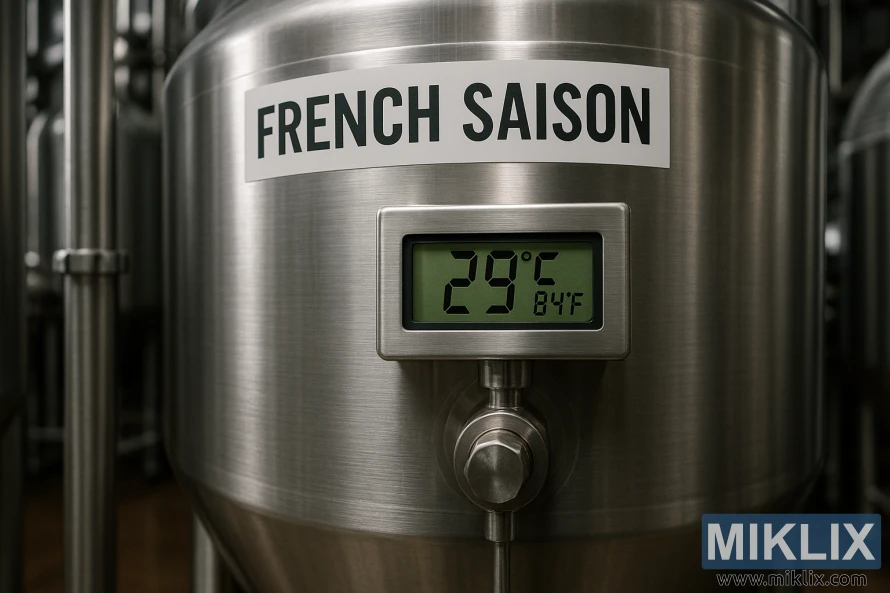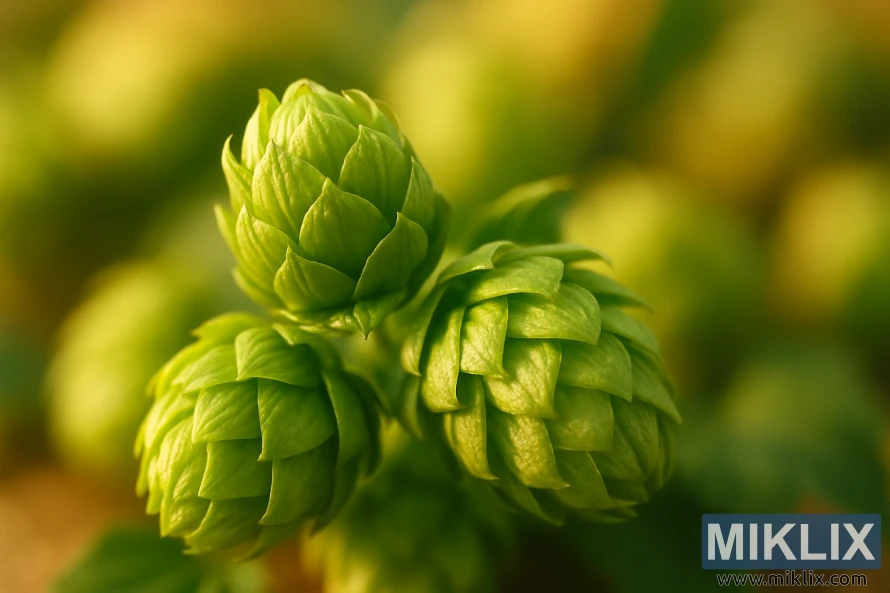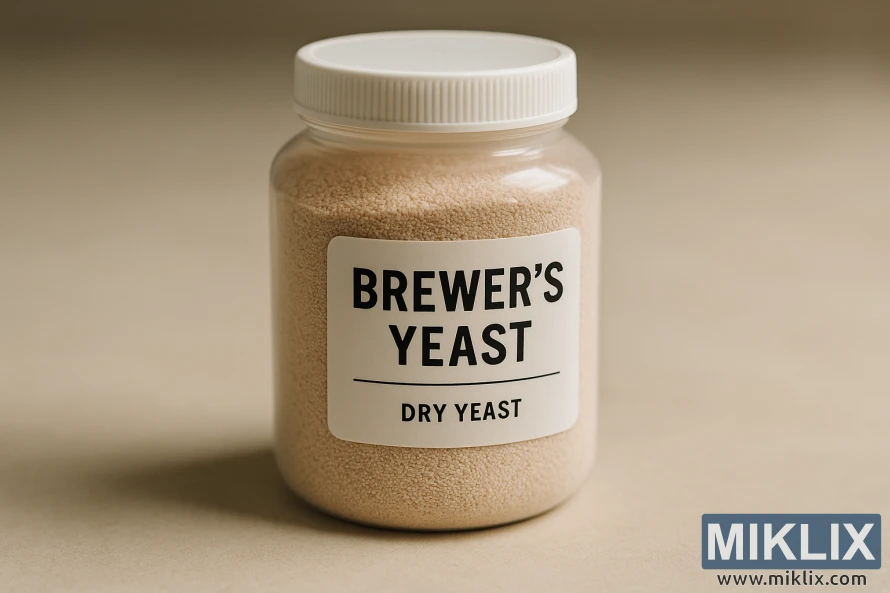Fermenting Beer with Mangrove Jack's M29 French Saison Yeast
Published: October 6, 2025 at 4:07:22 PM UTC
M29 is a dry Saccharomyces cerevisiae top-fermenting ale yeast from Mangrove Jack. It's marketed as a French Saison yeast. It has high attenuation near 85–90%, medium flocculation, and alcohol tolerance up to about 14%. This makes it ideal for dry, effervescent farmhouse ales and higher-ABV saisons.

Expect a spicy, fruity, and peppery profile from Mangrove Jack M29. It's known for clove, pepper, pear, orange peel, and light banana or bubblegum at warmer ferment temperatures. The strain tends to leave a very dry finish, with slight drying acidity and warming alcohol notes in stronger beers.
In this article, we'll present a Mangrove Jack M29 review. It will focus on practical pitching rates, temperature control, wort composition, and packaging tips. If you plan on fermenting with M29, these first notes should help you set expectations and choose recipes that highlight the strain’s strengths.
Key Takeaways
- Mangrove Jack's M29 French Saison Yeast is a dry, top-fermenting strain suited for farmhouse and Belgian-style saisons.
- Reported attenuation is high (about 85–90%), producing a characteristically dry finish.
- Flavor profile leans spicy and fruity with pepper, clove, and citrus notes.
- Alcohol tolerance near 14% makes M29 useful for both session and strong saisons.
- Practical guidance on fermenting with M29 will cover pitching, temperature, and recipe pairings in the following sections.
Why Choose Mangrove Jack's M29 French Saison Yeast for Your Brew
Homebrewers and professional brewers often turn to Mangrove Jack for a dependable French Saison yeast. The M29 strain is prized for its strong attenuation and ability to ferment cleanly at warm temperatures. This makes it perfect for crafting dry, refreshing farmhouse ales.
Those who prefer yeast-forward beers will find M29 appealing. It produces spicy, fruity esters and peppery phenolics that complement simple malt bills and moderate hopping. These flavors are ideal for both session saisons and higher-ABV versions, where complexity is key.
The yeast's practical benefits are significant. Available in dry format, it has a longer shelf life and withstands shipping stress better than many liquid yeasts. Its medium flocculation level aids in beer clarity while preserving the yeast's character.
When considering M29, remember its consistency, shelf stability, and the unique farmhouse character it brings to the table. These factors make it a standout choice for brewers aiming to create crisp, dry finishes and a slight drying acidity that enhances drinkability at higher ABV.
- Who it suits: brewers seeking high attenuation and warm fermentation tolerance.
- Distinctive character: spicy esters and peppery phenolics that dominate gentle malt backbones.
- Practical benefits: dry format stability, medium flocculation for balanced clarity.
When comparing strains, Mangrove Jack's M29 stands out for its ability to handle variable cell counts and warmer fermentations. It retains the French Saison yeast selection profile that many brewers desire. This combination of traits makes M29 a top choice for saisons and farmhouse-style ales.
Understanding the Fermentation Profile of M29
Mangrove Jack's M29 fermentation profile is distinct, aiming for a crisp, very dry finish in saisons. The reported attenuation ranges from 85–90%, with Beer-Analytics noting a specific 87.5% value. This means brewers can anticipate a lower final gravity than typical ale strains.
The yeast's flocculation is medium, leading to some haze unless cold-conditioned or filtered. This characteristic impacts the beer's clarity post-conditioning, depending on the chosen vessel or fining method.
Alcohol tolerance is around 14% ABV, according to manufacturer data. This tolerance allows brewers to craft strong farmhouse ales without compromising yeast performance at higher gravity worts.
Flavor production in M29 leans towards phenolic and fruity esters. Expect notes of clove, pepper, banana, pear, orange peel, and occasional bubblegum. Ester intensity varies with temperature and wort composition, so adjust mash and fermentation temperatures to shape the flavor profile.
Given the Saccharomyces cerevisiae saison profile in M29, it's crucial to enhance malt and hop complexity. The yeast's strong character complements rustic, spice-forward saisons and bold farmhouse interpretations.
Optimal Temperature Range and Practical Pitching Temperatures
Mangrove Jack's M29 excels in a warm range. It thrives between 26–32°C (79–90°F). This range enhances bright esters and a peppery, farmhouse character, typical of saisons.
Many brewers start by pitching cooler. They aim for 18–20°C (64–68°F). This cooler start helps avoid solventy off-flavors and controls ester and phenolic development.
Once the yeast is active, let the wort rise to the mid-to-high part of the M29 range. If it doesn't rise naturally, increase the ambient temperature to about 26°C after 48 hours. This ensures complete attenuation and the characteristic saison esters.
Fermenting saisons hot at the top of the range intensifies esters and phenolics. Temperatures of 30–32°C can bring bold fruity notes and a warming alcohol character. Be cautious of harsh solvent notes or excessive fusels at these high temperatures.
- Pitching practice: pitch temperature M29 at 18–20°C for cleaner early fermentation.
- Ramp strategy: allow a free rise or nudge to ~26°C after 48 hours to finish fermentation.
- High-temp caution: fermenting saisons hot near 32°C amplifies esters; watch aroma and off-flavors.
Accurate temperature logs and a reliable controller are crucial for the upper M29 range. A steady approach allows the strain to showcase farmhouse complexity while avoiding risky off-flavors.

Pitching Rates and Options for Dry M29 Yeast
Mangrove Jack's M29 is a forgiving dry yeast for homebrewers. Many wonder about the M29 pitching rate for a typical 5-gallon batch. Start with a standard ale pitching rate: roughly 0.75 to 1.0 million cells per milliliter per degree Plato. This works well for most average-strength saisons without special handling.
Dry yeast rehydration M29 can enhance cell viability, crucial for older packets or high-gravity beers. Rehydration involves warming sanitized water to 30–35°C (86–95°F) for 15–20 minutes. Then, gently stir and add it to the wort. Many brewers skip rehydration and still see good results in well-oxygenated wort.
High gravity worts demand extra care. For beers aiming at 8–10% ABV, increase the M29 pitching rate or rehydrate it. Consider a starter for a strong cell count in very high original gravities. Adequate oxygen at pitch reduces yeast stress and lowers stuck fermentation risk.
- For 5-gallon, standard-strength saison: follow packet guidance or use one full sachet at normal ale rates.
- For 1.070–1.080 OG: increase pitch rate by 25–50% or rehydrate before pitching.
- Above 1.090 OG or aiming near alcohol tolerance: step up pitch and oxygenation, and add yeast nutrient.
Fermentation support is key with M29. Ensure a measured oxygen dose at pitching, add balanced yeast nutrient for adjunct-heavy or high-gravity recipes, and maintain fermentation temperatures within the strain's recommended range. Good oxygen and nutrition, combined with the chosen M29 pitching rate, lead to a clean, vigorous fermentation.
When determining the M29 pitching rate, consider wort gravity, dry yeast age, and target ABV. These factors influence the decision between direct pitching, dry yeast rehydration M29, or building a starter. Apply conservative boosts for challenging worts to safeguard yeast health and beer quality.
Wort Composition and Grain Bills for Saison Styles
For a simple saison grain bill, let yeast character shine. Use base malts like Pilsner or pale ale malt for a light, clean backbone. Vienna or light Munich can add a touch of breadiness without overpowering the flavor.
Keep specialty malts minimal. Add 5–10% wheat or flaked oats to enhance head retention and mouthfeel. A small portion of light caramel malt can add body. But avoid heavy crystal or roasted malts, as they can mask saison esters.
- Base malt: 85–95% Pilsner or pale ale.
- Supporting malts: 3–8% Vienna or light Munich.
- Adjuncts and specialty: 2–6% wheat, oats, or light caramel.
Plan malt choices for M29 to complement its spicy, peppery, and citrus notes. M29’s fermentation profile will dominate, so match grain color and sweetness to keep yeast in the spotlight.
Target wort gravity for saisons based on style and alcohol goals. Many saisons start moderate, near 1.050–1.060 OG. Farmhouse triples or stronger versions may push higher. Adjust fermentables to reach the desired ABV without overwhelming fermentability.
Aim for a mash temperature on the lower side to boost fermentability. For saisons, a mash around 148–150°F (64–66°C) favors simpler sugars. Use a small amount of diastatic malt or well-modified base malt if you plan a high adjunct load.
When designing a saison grain bill, think about balance. Let the malt support body and color while malt choices for M29 and mash regimen provide fermentability. This approach helps M29 achieve a dry finish and lively character.
Hop Choices and How They Interact with M29 Flavor Profile
Mangrove Jack's M29 is known for its peppery and fruity esters. When selecting hops for a saison, consider the yeast as the main character. Opt for hops that either complement the yeast's orange and pear notes or provide a contrasting element.
For a traditional farmhouse taste, European hops are ideal. Saaz, East Kent Goldings, and Styrian Goldings add gentle herbal and floral notes. Use them to support M29's character. Aim for moderate bitterness and focus on late additions for aroma to highlight the yeast.
Modern American and southern hemisphere hops can create a dynamic contrast with M29. Citrus and piney hops add a bold punch to contemporary brews. Consider late whirlpool additions or dry hopping to showcase these oils without overpowering the yeast esters.
Adjust hop rates based on the desired role. For yeast-forward saisons, keep IBU moderate and emphasize finishing hops or light dry hopping. Excessive hopping can overshadow the yeast, making the beer taste more like an IPA.
- Complement: Saaz and East Kent Goldings to enhance farmhouse spice.
- Contrast: Citra, Amarillo, or Nelson Sauvin for citrus lift when hopping with M29.
- Technique: Late kettle whirlpool and dry hop for aroma without harsh bitterness.
View hop pairing M29 as a balance challenge. Match hop-derived citrus, herbal, or floral notes with the yeast's orange and pear esters for harmony. For contrast, choose bold modern hops and reduce yeast masking by adjusting malt richness.
When crafting a recipe, start with small batches. Experiment with hop timing and rates to achieve the perfect balance. This approach allows you to refine your hop pairing M29, whether you prefer subtle or bold contrasts.

Water Chemistry and Mash Considerations for Farmhouse Ales
Begin with a clean, balanced water profile. For water profile saisons, aim for a chloride-to-sulfate ratio that slightly favors sulfate. This moderate sulfate enhances dryness and hop bite, preserving the soft, peppery yeast character.
Before brewing, check the carbonate levels. High levels can mute the delicate spice notes in saison recipes. Use reverse osmosis water or dilute hard municipal supplies to maintain a gentle, focused profile.
Mash pH for M29 should be near 5.2–5.4 at mash temperature. This range optimizes enzyme activity and ensures a highly fermentable wort. Use a reliable pH meter and adjust with calcium chloride, gypsum, or food-grade acids to achieve the target.
Calcium is beneficial but should be moderate. Aim for enough Ca2+ to support yeast health, flocculation, and enzyme function without imparting an overly hard water taste. Typical targets around 50–100 ppm calcium are suitable for farmhouse styles.
Plan a mash schedule that favors fermentability. Use lower saccharification temperatures, such as 148–152°F (64–67°C), to produce more simple sugars. This pairs well with M29's high attenuation, aiming for the classic dry finish of saisons.
When adjusting minerals, make small steps. Add gypsum to increase sulfate and calcium chloride for a rounder malt presence. Balance these additions to enhance the peppery, fruity esters of M29 without masking them.
For precise results, track mash pH and ionic adjustments in each batch. Consistent water profile saisons depend on steady mash pH for M29 and mindful water chemistry that respects the yeast's expressive nature.
Fermentation Scheduling and Vessel Selection
When selecting a fermenter for saison, consider your brewing scale and handling preferences. Stainless conical fermenters offer advantages in yeast removal and temperature control. For small batches and clarity, glass carboys are a good choice. Beginners might prefer food-grade plastic fermenters for their lightness and affordability.
Develop an M29 fermentation schedule that begins with cooler temperatures. Pitching between 18–20°C allows the yeast to establish a clean activity base. After 48 hours, monitor airlock activity and krausen. If activity is slow, incrementally increase temperatures to 26–32°C to foster the distinctive saison fermentation profile.
During the most active phase, maintain consistent peak temperatures. This promotes full attenuation and enhances the expression of M29's peppery and fruity characteristics. Employ a fermentation chamber or use a heat belt for ambient temperature control. A temperature controller is crucial for preventing extreme temperature fluctuations.
The duration of fermentation hinges on the beer's gravity and the pitch rate. Beers with lower to moderate gravity often exhibit vigorous activity within the first day. They may finish primary fermentation more quickly at higher temperatures. Longer conditioning periods are necessary for cold-aging to achieve clarity and flavor refinement.
- Fermentation vessel choices: pick a conical for yeast harvest, a carboy for visual checks, or plastic for easy handling.
- M29 fermentation schedule: cool pitch, assess at 48 hours, raise to target if needed, maintain through peak, then gradual cool-down.
- Temperature control tools: heat belts, insulated wraps, fermentation chambers, or ambient heating solutions.
Keep a detailed record of temperatures and gravity readings. A comprehensive log facilitates the replication of successful brews. Ensure your fermentation vessel choices align with your workflow and available space to maintain consistency and efficiency.
Monitoring Fermentation: Gravity, Temperature, and Sensory Cues
Start by tracking gravity readings M29 from the beginning. Record the original gravity and then take daily readings of final gravity until they stabilize for 48–72 hours. M29 typically reaches attenuation levels of 85–90%. Use a sanitized hydrometer or a refractometer with alcohol correction for accurate measurements.
Keep a simple temperature log. Record room and wort temperatures every few hours in the first two days and daily thereafter. M29 can undergo free-rise, so logging these temperatures helps correlate ester production with temperature fluctuations. This information aids in deciding when to cool or insulate the fermenter.
Use fermentation sensory cues to assess yeast health. Smell the airlock and a small gravity sample for typical saison notes like pepper, clove, pear, and orange. These aromas usually indicate active and healthy yeast.
Be vigilant for warning signs. Stalled gravity, solvent-like aromas, or a very low krausen that never develops can signal issues such as low pitch rate, poor oxygenation, or nutrient deficiencies. Address these problems promptly to prevent stuck fermentations.
- How to act on stalled gravity: verify temperature, oxygenation history, and viable pitch rate before adding nutrients or a fresh starter.
- Responding to harsh solvent notes: check recent temps and consider a gentle cooldown or re-pitch with a healthy culture if stress is confirmed.
- When to leave it alone: steady gravity readings M29 and stable sensory cues mean the beer needs time to clean up and finish conditioning.
Combine numerical tracking with your senses for the best results. Gravity readings M29 provide objective progress, temperature logs reveal patterns, and fermentation sensory cues offer early warnings. Together, they guide you towards a clean, lively saison.
Managing High-Temperature Fermentation Risks
Mangrove Jack's M29 can produce lively esters when warmed, but M29 high temperature risks rise near 32°C (90°F). At that range, yeast stress can generate strong phenolics and solventy, fusel notes. These notes can mask delicate pepper and fruit flavors. Brewers planning a warm saison should respect those limits.
To manage hot fermentation, begin cooler. Pitch between 18–20°C and keep the wort there for the first 36–48 hours. A controlled ramp later will coax the desired ester profile without triggering excessive off-flavors saison yeast is prone to when stressed.
Oxygenation and pitch rate matter. Adequate oxygen at aeration and a healthy cell count cut stress and reduce the chance of solvent formation. For high-gravity batches, increase pitch rate and add yeast nutrients. This helps avoid stuck or stressed fermentations and limits M29 high temperature risks.
Watch for signs of trouble: sharp solvent notes, hot fusels, or stalled gravity. If solvent off-notes appear, lower the temperature and assess yeast health. Gentle rousing often helps; in extreme cases, repitching with active cells can rescue a fermentation. This reduces off-flavors saison yeast may carry into the finished beer.
- Start cool (18–20°C) and hold for 48 hours
- Raise temperature slowly to shape esters
- Ensure strong oxygenation and nutrition
- Boost pitch for high-gravity beers
- Lower temp or rouse yeast if solvent notes emerge
Conditioning, Maturation, and Packaging Considerations
After primary fermentation, move the beer to a slightly cooler space for conditioning. Lower temperatures help yeast clean up off-flavors and let particulates settle. Mangrove Jack's M29 has medium flocculation, so expect some yeast to remain in suspension.
Maturation for a saison varies with strength. For standard-strength ales, two to four weeks of conditioning often smooths esters and balances phenolics. For higher ABV saisons, extend the maturation saison period to allow warming alcohol notes to integrate and mellow.
- Cold crash or fining can speed clarity if a bright pour is desired.
- Use gentle fining when you want to preserve delicate yeast-driven aroma.
- Consider leaving some yeast for natural bottle conditioning if you prefer live carbonation.
Carbonation level defines much of a saison's character. Aim for lively, effervescent carbonation when packaging saison beers to emphasize peppery and fruity notes. Confirm final gravity is stable over several days before bottling to avoid excess pressure from remaining fermentables.
When choosing between kegging and bottling, remember that bottle conditioning requires careful priming calculations and patient maturation. Filtration before force-carbonating in a keg will produce a clear, bright result but removes conditioning yeast. Match your packaging plan to the desired mouthfeel and shelf life.
Troubleshooting Common Issues with M29 Fermentations
Stalled fermentations are a common issue with Mangrove Jack's M29. Causes include underpitching, low wort oxygen, or brewing high gravity without adjusting the yeast. To address stuck fermentation, gently warm the yeast to its upper range. Carefully aerate if fermentation is still active and add a balanced yeast nutrient. If there's no activity after 48–72 hours, repitch with a healthy ale strain like Wyeast 3711 or White Labs WLP565.
Solvent and fusel alcohol notes suggest yeast stress or high temperature during fermentation. To avoid these issues, control fermentation temperature and ensure proper pitching rates. Always oxygenate wort before pitching and verify yeast viability, even with older or stored packs.
Esters or phenolics dominating the flavor indicate yeast stress or high fermentation temperature. To prevent this, control fermentation temperature and use proper pitching rates. Oxygenate wort before pitching and check yeast viability, even with older or stored packs.
Clarity and persistent haze are common with medium-flocculation saison strains. To improve clarity, use cold conditioning, fining agents like gelatin or isinglass, or light filtration. Remember, some haze is style-appropriate for farmhouse ales and does not indicate a fault.
- Common fixes for stalled batches:
- Gently raise temperature by 2–4°F to encourage activity.
- Add oxygen if CO2 production is present and yeast still active.
- Supplement with yeast nutrient or trace minerals.
- Repitch with a vigorous, compatible yeast if no recovery.
- Addressing off-flavors:
- Lower fermentation temperatures and avoid heat spikes.
- Confirm pitching rate and wort oxygenation for next brew.
- Consider shorter warm rest or different adjuncts to reduce stress.
- Improving clarity:
- Cold crash for several days before packaging.
- Use fining or gentle filtration.
- Accept light haze if it matches the saison profile.
For systematic M29 troubleshooting, keep detailed logs of pitch date, gravity, temperature curve, and any oxygenation steps. These records shorten diagnosis time when saison fermentation problems appear. Careful attention to pitching rate, oxygen, and temperature control are the fastest ways to fix stuck fermentation M29 and prevent repeat issues.

Recipe Ideas and Example Builds Using M29
Begin with a traditional farmhouse saison as a solid foundation. Mix 85–90% Pilsner malt with 5–10% wheat or Vienna. Mash at a slightly lower temperature to enhance fermentability. Aim for an original gravity that aligns with your desired alcohol by volume (ABV).
Pitch M29 at 18–20°C and let it rise freely to 26°C. This temperature range is crucial for developing the desired ester and pepper notes.
To brew a higher ABV saison, increase the fermentable ingredients and the yeast pitch rate. Introduce oxygen at the time of pitching and consider adding yeast nutrients within the first 24 hours. These adjustments ensure M29 finishes clean and handles osmotic stress effectively.
- Example saison build for low ABV: OG 1.044, 88% Pilsner, 7% wheat, 5% Vienna; Saaz hops; pitch M29; start 18°C, free rise to 24–26°C.
- Example saison build for higher ABV: OG 1.066, 80% Pilsner, 10% Munich, 10% sugar adjunct; moderate pitch; oxygenate; monitor closely.
Hop-driven variants allow hops to interact with the yeast. Opt for Saaz or Styrian Goldings for their spice and floral notes. For contrast, incorporate modern citrus hops like Citra or Amarillo. Keep bitterness in check to ensure M29 remains the star of the flavor profile.
Spiced or fruit saisons benefit from late additions. Incorporate citrus peel, cracked pepper, or stone fruit during conditioning to preserve volatile aromatics. M29's orange, pear, and pepper notes complement these subtle adjuncts beautifully.
- Simple grain bill: Pilsner malt base, small wheat addition, mash for fermentability.
- Pitching and temp plan: 18–20°C start, allow free rise to mid-20s Celsius.
- Adjunct timing: Add spices or fruit post-primary to keep aroma bright.
These M29 recipes serve as a starting point for your brewing journey. Feel free to adjust the grain bill, OG, and hop choices to create a unique saison. The example builds provided offer a clear framework for experimentation and refinement.
Comparisons and Benchmarks: How M29 Performs in the Real World
Mangrove Jack M29 benchmarks consistently show high apparent attenuation of 85–90%, medium flocculation, and steady activity at warm fermentation temperatures. This makes M29 a reliable choice for brewers aiming for a dry, yeast-forward saison. Its traits align perfectly with the desired profile.
In real-world comparisons, M29 often outshines neutral ale yeasts with its phenolic and spicy character. Both homebrewers and professional brewers frequently include M29 in their saison and farmhouse ale recipes. It is celebrated for producing peppery esters and a clean, dry finish. The use reports closely mirror the manufacturer's guidance on temperature and flavor outcomes.
When comparing M29 to other saison yeasts, its distinction in attenuation and heat tolerance is evident. M29 ferments more fully and tolerates warmer temperatures without off-flavors. While other saison strains may offer subtler spice or more banana ester notes, they sometimes leave the beer higher in final gravity.
Mangrove Jack M29's strengths make it ideal for yeast-driven recipes. Opt for M29 if you aim to have the yeast be the star in a pale, single-malt saison or a hopped farmhouse ale. It's less suitable for malt-forward saisons where delicate caramel or biscuit malts need to remain prominent.
- Performance: High attenuation, reliable warm-temp fermentation.
- Flavor: Pronounced spicy and fruity esters versus neutral ale strains.
- Use cases: Best when yeast character is central to the beer.
For brewers comparing strain options, testing small batches is essential. This allows for evaluating M29 against preferred saison strains. Tasting side-by-side reveals how M29 dries the beer and emphasizes phenolic spice. These trials provide practical benchmarks for guiding recipe choices and fermentation management.
Safety, Storage, and Purchasing Tips for Mangrove Jack Yeast
For optimal performance, store Mangrove Jack yeast in a cool, dry environment. Refrigeration is ideal for unopened packets. This method extends shelf life and maintains fermentation quality.
When purchasing M29, opt for well-established homebrew suppliers or Mangrove Jack's authorized retailers. Always check the production and expiration dates. Note the batch numbers if provided. Buying from trusted sources minimizes the risk of receiving degraded or counterfeit products.
Adhere to the manufacturer's rehydration instructions for the best outcomes. If you prefer, you can directly pitch the dry yeast into the wort. Always maintain strict sanitation when handling yeast to avoid contamination.
M29 safety aligns with other food-grade brewing yeasts. It poses no unique hazards beyond the typical risks associated with brewing. Ensure your equipment remains clean and adhere to local alcohol production regulations if you plan to sell your beer.
- Refrigerate unopened packets to maximize viability.
- Verify production/expiration dates before purchase.
- Use clean tools and sanitizer during rehydration or pitching.
- Keep records of supplier and batch for quality tracking.
If you must store opened packets for a short period, reseal them and keep them cool. For longer storage, maintaining cold temperatures and low humidity is crucial to preserve yeast viability.
When buying, prioritize reputable retailers. Confirm their return or replacement policies. Clear labeling and traceable batch information are key to ensuring consistent performance when purchasing M29 for your next brewing project.

Conclusion
Mangrove Jack's M29 French Saison yeast is a reliable choice for brewing dry, spicy, and fruity farmhouse ales. When fermented within its 26–32°C comfort zone, it produces high attenuation and a robust ester profile. This makes M29 an excellent option for saisons and other rustic styles.
To achieve controlled results, pitch the yeast at typical ale temperatures (18–20°C). Allow it to settle, then encourage a rise to 26°C after 48 hours for enhanced phenolics and dryness. For high-gravity batches, increase the pitch rate and oxygenation to prevent stalls and maintain a clean finish.
Opt for simple grain bills and choose hops that complement the yeast's character, rather than competing with it. Proper storage, close monitoring of fermentation, and timely adjustments are key to avoiding common issues. In summary, the M29 strain is both versatile and forgiving, making it a dependable choice for brewers aiming to create authentic farmhouse ales.
Further Reading
If you enjoyed this post, you may also like these suggestions:
- Fermenting Beer with Lallemand LalBrew New England Yeast
- Fermenting Beer with White Labs WLP802 Czech Budejovice Lager Yeast
- Fermenting Beer with Wyeast 1098 British Ale Yeast
